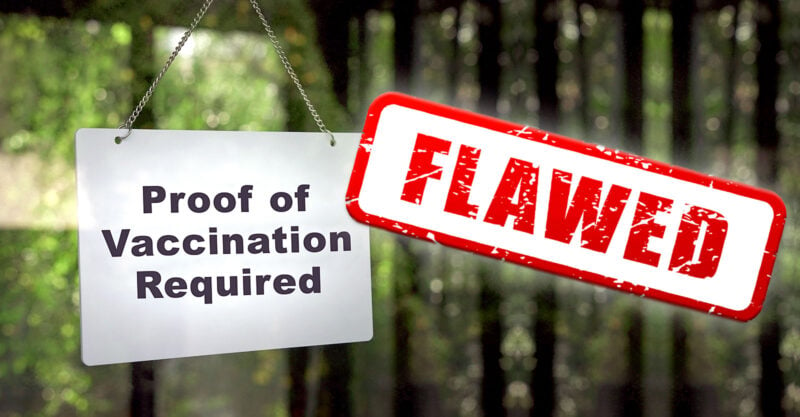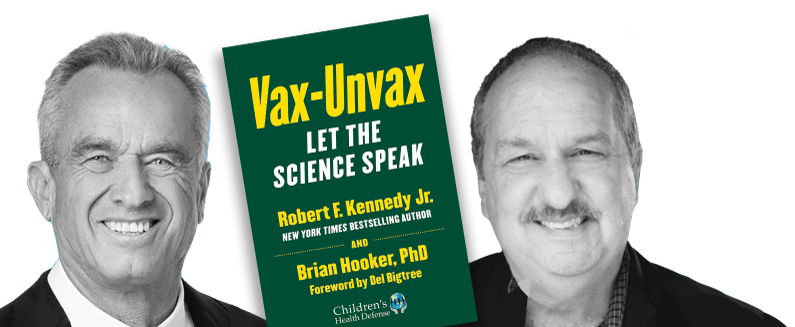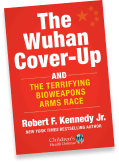Author of Study Used to Vilify Unvaxed Had Ties to Pfizer — New Peer-Reviewed Research Shows Why the Study Was Flawed
A new peer-reviewed study by researchers Joseph Hickey, Ph.D., and Denis Rancourt, Ph.D., re-examined the mathematical models used to justify policies that barred unvaccinated people from public venues. They found the models were based on the application of flawed mathematical risk models.
Miss a day, miss a lot. Subscribe to The Defender's Top News of the Day. It's free.
During the COVID-19 pandemic, politicians, scientists and media organizations vilified unvaccinated people, blaming them for prolonging the pandemic and advocating policies that barred “the unvaccinated” from public venues, businesses and their own workplaces.
But a peer-reviewed study published last week in Cureus shows that a key April 2022 study by Fisman et al. — used to justify draconian policies segregating the unvaccinated — was based on the application of flawed mathematical risk models that offer no scientific backing for such policies.
Dr. David Fisman, a University of Toronto epidemiologist was the lead author of the April 2022 study, published in the Canadian Medical Association Journal (CMAJ), which the authors said showed that unvaccinated people posed a disproportionate risk to vaccinated people.
Fisman has worked as an adviser to vaccine makers Pfizer, Seqirus, AstraZeneca and Sanofi-Pasteur. He also advised the Canadian government on its COVID-19 policies and recently was tapped to head up the University of Toronto’s new Institute for Pandemics.
Fisman told reporters the key message of the study was that the choice to get vaccinated is not merely personal because if you choose to be unvaccinated, you are “creating risk for those around you.”
The press ran with it.
Headlines like Salon’s, “Merely hanging out with unvaccinated puts the vaccinated at higher risk: study,” Forbes’ “Study Shows Unvaccinated People Are At Increased Risk Of Infecting The Vaccinated” or Medscape’s “My Choice? Unvaccinated Pose Outsize Risk to Vaccinated” proliferated in more than 100 outlets.
The Canadian Parliament used the paper to promote restrictions for unvaccinated people.
However, in the new study published last week, Joseph Hickey, Ph.D., and Denis Rancourt, Ph.D., show that Fisman’s “susceptible-infectious-recovered (SIR)” model, used to draw his conclusions, had a glaring flaw in one of its key parameters — contact frequency.
When they adjusted that parameter to account for real-world data, the model produced a variety of contradictory outcomes, including one showing that segregating unvaccinated people can increase the epidemic severity among the vaccinated — the exact opposite of what Fisman et al. purported to show
Hickey and Rancourt, researchers at Canada’s Correlation: Research in the Public Interest, concluded that without reliable empirical data to inform such SIR models, the models are “intrinsically limited” and should not be used as a basis for policy.
The Canadian researchers attempted to publish their paper in CMAJ, where Fisman had published his original study, but the editor — a collaborator of Fisman’s — refused even to review it.
The open-access version of CMAJ also declined to publish the article even after it received favorable peer reviews.
In a letter sent, with supporting documentation, to the CMAJ and the Canadian Medical Association, Hickey and Rancourt recounted the “tedious saga” whereby the journal editors “concocted a multitude of ancillary and unnecessary objections, apparently intended to be insurmountable barriers” to publishing their study.
They later published the study in the peer-reviewed journal Cureus.
Rancourt tweeted a link to the study results along with a montage of pandemic-era media clips scapegoating unvaccinated people.
‘A policy based on nothing’
SIR models were commonly used as the basis for pandemic policies, often with fatal flaws research has since shown.
Fisman et al. designed their study to measure the impacts of segregating two groups — vaccinated and unvaccinated people — applying a SIR model to predict whether the unvaccinated pose an undue risk to the vaccinated during a severe acute respiratory viral outbreak, based on variable degrees of mixing among the groups.
However the model, Hickey and Rancourt wrote, failed to consider the impacts of that segregation on “contact frequencies,” a key parameter in predicting epidemic outcomes.
Instead, it assumed contact frequencies among the majority (vaccinated) and socially excluded (unvaccinated) groups would be equal and constant, which “is not realistic,” Hickey told The Defender.
In other words, the model assumed the two groups would be separated, yet living the same parallel existence — socializing, working, shopping and coming into contact with others in exactly the same ways.
But in the real world, segregation meant the unvaccinated were barred from many public places, so their contact frequencies were severely curtailed.
Hickey and Rancourt implemented the SIR model again, testing for a degree of segregation that ranged from zero to complete segregation and allowing the contact frequencies for individuals in the two groups to vary with the degree of segregation.
When they ran the model using the more realistic estimation of how different segregation policies might generate different contact frequencies among the two groups, “we found the results are all over the map,” Hickey said.
By segregating unvaccinated people from the vaccinated majority, he said, “You can have an increase in the attack rate among vaccinated people or you can have a decrease.”
“Negative epidemiological consequences can occur for either segregated group, irrespective of the deleterious health impacts of the policies themselves,” they wrote.
Hickey said the variable outcomes were very sensitive to the values of the parameters in the model, namely infectious contact frequency.
But he said, in the real world there are no reliable measures for contact frequency, and without reliable measures for model inputs, the model is essentially meaningless.
They concluded that the degree of uncertainty is so high in such SIR models that they cannot reasonably inform policy decisions.
“It’s a policy based on nothing basically,” Hickey said.
“We cannot recommend that SIR modelling be used to motivate or justify segregation policies regarding viral respiratory diseases, in the present state of knowledge,” the study concluded.
‘Fisman’s Fraud’
Modeling had a major impact on the pandemic response in Canada and globally, statistician Regina Watteel, Ph.D., who chronicled the impact of the Fisman paper in her book “Fisman’s Fraud: the Rise of Canadian Hate Science,” told The Defender.
As a key figure in modeling the pandemic in Canada, Fisman “was involved in Canada’s pandemic response at all levels,” she said.
He was also influential as a public figure, making numerous disparaging comments about “anti-vaxxers” from early on and advocating policies like vaccine passports and school closures long before he received a major grant from the Canadian Institutes of Health Research for his SIR modeling study.
Fisman was open in interviews about the fact that the point of the 2022 study was to “undermine the notion that vaccine choice was best left to the individual,” Watteel said.
The 2022 modeling paper didn’t just present mathematical results, the authors also made political claims.
“The choice of some individuals to refuse vaccination is likely to affect the health and safety of vaccinated people in a manner disproportionate to the fraction of unvaccinated people in the population.
“Risk among unvaccinated people cannot be considered self-regarding, and considerations around equity and justice for people who do choose to be vaccinated, as well as those who choose not to be, need to be considered in the formulation of vaccination policy.”
Despite serious concerns raised by numerous researchers in the CMAJ article’s response section, the mainstream international press widely promoted the article as proof the unvaccinated posed a danger to the vaccinated.
Fisman publicly advocated for vaccine mandates and passports and told reporters the impetus behind the modeling study was not a scientific question of the effects of segregation on infection rates, but the political question of, “What are the rights of vaccinated people to be protected from unvaccinated people?”
A few days after the study was published, the parliamentary secretary to the Ontario Ministry of Health used the study to defend proposed travel restrictions, Watteel showed in her book.
As a result, she wrote, it “has generated a massive trail of misinformation.”
Watteel concurred that Fisman et al.’s study was based on bad modeling. She added that by omitting publicly available current data that contradicted the data they presented in the article, the study was actually “fraudulent.”
Fisman et al. published the paper during the so-called Omicron surge, which was dominated by infections among the fully vaccinated. By spring 2022, people who were boosted had disproportionately more infections than others, according to data on the government of Ontario COVID-19 website and reproduced in Watteel’s book.
However, none of that publicly available data was included in the study.
Instead, Watteel wrote:
“Fisman et al. concocted a model to generate the results they wanted, completely omitting any reference to readily available real-world data that contradicted their results (falsification). They went on to state the contrived results as facts (data fabrication) and then proceeded to inform public policy based on the fabricated results.
“The researchers continued to push the false narrative long after numerous scientists rebuked the findings and provided evidence of the findings’ falsity. This indicates a willful misrepresentation and misinterpretation of research findings.”
CAMJ editor, Fisman colleague, blocks review of Correlation article
Hickey told The Defender when they submitted their paper critiquing SIR models like Fisman’s to CAMJ in August 2022, editor Matthew Stanbrook, M.D., Ph.D. — who also works at the University of Toronto and has collaborated with Fisman on academic articles, grants and courses — rejected the article without even sending it for peer review.
Hickey and Rancourt appealed the decision and requested Stanbrook recuse himself. The journal suggested they resubmit their study to the open-access version of CAMJ, which they did. It was rejected without going through peer review.
They appealed that decision and the paper was sent for review. A few months later, they received two positive reviews with requested corrections. They responded to the reviews and made corrections to the paper, expecting publication.
The journal then informed them there had been a “technical error” and the journal — which is supposed to have an entirely transparent peer-review process — had failed to send them concerns from anonymous internal editors and an anonymous statistician.
Hickey told The Defender:
“It is their policy that the reviewers’ names are public and that the review reports and the revision, like the responses by the author, all that stuff is public. That’s the policy. There’s no escaping that.
“And yet what do they do? They use anonymous internal people to put barriers up and make pretexts to not publish even in the face of positive reviews.”
Those anonymous comments included a suggestion that they should use Fisman’s flawed mathematical analysis, Hickey said. The authors responded to those comments in what they have now also posted on their website as a stand-alone article.
Months later, they requested an update on the journal’s plans for the article and were informed that the journal decided the article would not be suitable for its audience and suggested they instead publish in a modeling journal.
All of their collected critiques of Fisman’s 2022 paper are also collected on the Correlation website.
Sign up for free news and updates from Children’s Health Defense. CHD focuses on legal strategies to defend the health of our children and obtain justice for those injured. We can't do it without your support





